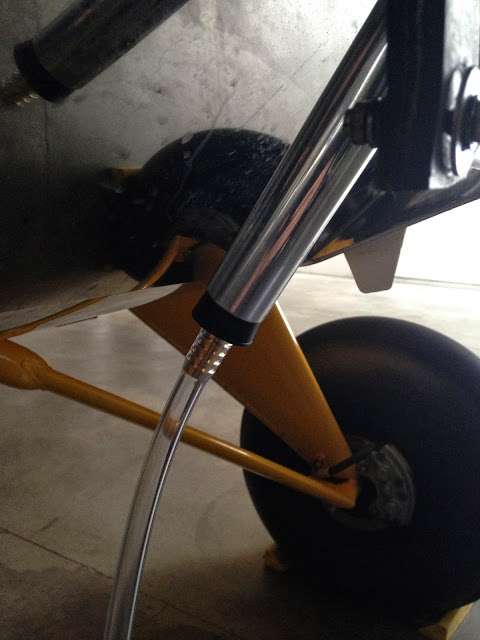Most of the life of this engine has been using Aeroshell 15W-50 aviation oil. For the last two years, I switched to Phillips 20W-50 and added Camguard. For the life of this particular cam shaft and tappets (which were replaced at about 1100 hours with reconditioned parts), that was about 700 hours of which a little over 300 hours was with the Phillips/Camguard combination. I have been doing some reading and getting opinions from many experienced pilots and mechanics and have had a very wide range of what is considered to be the optimal choice. At this point I haven't decided which route to go, but I do have a good idea of the protocol to follow for the engine break in from Lycoming and Tim's experience. The consistent point of agreement about reducing corrosion in an airplane engine was to fly it as much as possible and for at least 45 minutes to an hour minimum time on each flight.
An idea I had was to devise a way to decrease the amount of moisture inside of the crankcase when the engine was not running. I keep the plane in an unheated metal hangar at Paine Field (KPAE) and especially during our moist and long winters the relative humidity inside of the hangar is often high enough to have condensation on the walls and concrete floor. After searching the internet I found a couple of ideas about building an air dehydrator. The idea was to circulate dry air through the case while the plane was not being flown.
I did some more research and found that there are a variety of desiccants that would work for this application. The most readily available was Silca gel which I found at a local crafts store where it was used to dry flowers. Silica gel (http://en.wikipedia.org/wiki/Silica_gel) is a granular, vitreous, porous form of silicon dioxide made synthetically from sodium silicate.
Silica gel has many properties that make it a good desiccant.
- It will adsorb up to 40% of its own weight in water vapour. This adsorption efficiency is
approximately 35% greater that typical desiccant clays, making silica gel the preferred choice where
weight or efficiency are important factors.
- It has an almost indefinite shelf life if stored in airtight conditions.
- It can be regenerated and reused if required. Gently heating silica gel will drive off the adsorbed
moisture and leave it ready for reuse. 250 degrees F for 2-3 hours.
- It is a very inert material, it will not normally attack or corrode other materials and with the
exception of strong alkalis and hydrofluoric acid is itself resistant to attack.
- It is non-flammable.
- It is most frequently and conveniently used packed in a breathable sachet or bag. These are
available in a wide range of sizes suitable for use with a wide range of applications.
Another material that can reduce the relative humidity even lower is called molecular sieve.
Molecular sieves are desiccants with differing properties to those of silica gel. With the appearance of small opaque pinkish beads, molecular sieves are synthetically produced, highly porous crystalline metal-aluminosilicates. They have many internal cavities that are linked by window openings of precise diameters. It is these diameters (measured in Ångstroms) that classify molecular sieves - 3Å, 4Å, 5Å, and 10Å (also known as 13X). Adsorption occurs only of molecules with smaller diameters than these cavity openings. Larger molecules will be excluded from adsorption. Preferentially adsorbed are molecules of greater polarity.
This makes molecular sieves ideal for adsorption of water from air and liquids, as water molecules are both polar and very small. Molecular sieves will adsorb water molecules and other contaminants from liquids and gases down to very low levels - often just 1 part per million.
Molecular sieves properties as desiccants differ from silica gel in a number of ways :
(1) They adsorb water vapour more rapidly than silica gel.
(2) They will reduce water vapour to much lower levels than silica gel, making their use essential
when a very dry product or atmosphere is required.
(3) They perform more effectively as moisture adsorbers at higher temperatures (greater than 25°C) than silica gel does.
This makes molecular sieves ideal for adsorption of water from air and liquids, as water molecules are both polar and very small. Molecular sieves will adsorb water molecules and other contaminants from liquids and gases down to very low levels - often just 1 part per million.
Molecular sieves properties as desiccants differ from silica gel in a number of ways :
(1) They adsorb water vapour more rapidly than silica gel.
(2) They will reduce water vapour to much lower levels than silica gel, making their use essential
when a very dry product or atmosphere is required.
(3) They perform more effectively as moisture adsorbers at higher temperatures (greater than 25°C) than silica gel does.
The goal in the end is to get the relative humidity inside of the crankcase under 40% where the corrosion process greatly reduces.
I have built a prototype dryer using some sealed plastic container, an aquarium pump, vinyl tubing and rubber stoppers.
I bought an inexpensive digital hygrometer from Home Depot to monitor the effectiveness of the set-up.
After running the pump for 15 minutes and having the system closed, the relative humidity dropped from 78% to 20%. When I went back to the hangar a week later it had dropped to 16%.
The idea is to circulate the air through the oil breather tube and the exhaust pipes and draw air back out through the oil fill tube.
A final part to the system is a toaster oven to heat the silica gel once it adsorbs the water and recharge for further use. I am anxious to give this a try, seems like it should work. Just need to get the engine parts back to start reassembly first.








No comments:
Post a Comment